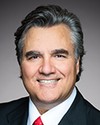Thank you very much, Madam Chair.
Thank you all for being here this morning for the committee’s study on the possible review of the Navigation Protection Act.
Like you, I was astonished from the outset at the manner in which the committee began its study on the Navigation Protection Act. We are currently studying future amendments, amendments that the government seems to have already decided to make without telling us about them. This is a concern for our party.
In fact, on several occasions, the Minister of Transport and the Minister of Fisheries, Oceans and the Canadian Coast Guard have clearly indicated they would like to make amendments to the act and re-establish protections that were in the previous version of the act, before the most recent amendments.
In parallel, the minister committed, in the letter he sent to the committee, to hold his own consultations with aboriginal communities and with the various groups involved. To our great surprise, during an appearance before the committee, the Minister of Transport dismissed the consultations held by the Department of Transport itself, which sought to find out the expectations and needs, and rather to hold a more formal consultation with a view to justifying the potential amendments to the Navigation Protection Act.
With my colleagues, I have had a number of occasions to quote different passages from letters the minister has sent us, so I will not go back over them. However, I am a little surprised to see that even Transport Canada has decided to make hearings of this committee into official Transport Canada consultations. My experience in Parliament is short, but I have not often seen that.
In a letter, counsel for the Heiltsuk Nation writes:
I am writing to you because Deputy Minister Michael Keenan has invited Chief Marilyn Slett to state again that the First Nation would like to appear before the Standing Committee on Transportation.
So the deputy minister is asking a chief to repeat her wish to appear before the committee rather than asking the first nation to send its comments directly to Transport Canada officials. I confess that I find that very surprising.
I quote from another letter, this one written by Mr. Keenan:
…we will be in touch with the committee to encourage it to hear what the coastal First Nations and the Heiltsuk First Nation have to say.
So you can somewhat understand our shock at this process. We would have liked to be able to discuss your proposals and propose potential changes to the act. In fact, it has been stated, on a number of occasions, that the minister is going to make changes to the act. We would have liked to hear what you have to say about those amendments.
Ms. Hoyt, I accept what you said just now about the number of requests for opinions about the various changes. It must be very difficult for a small organization like yours to follow the developments, in comparison to the huge machine of the federal government. You also have to deal with local and provincial communities. So I imagine that the fact of coming back before the committee to restate your comments on the matter will add an additional workload to your community.
I was listening to your concerns about the protection of waterways, which seem perfectly legitimate to me. In your opinion, would such a review of protection measures require Transport Canada to hold wider consultations directly with your communities?
Ms. Hoyt, perhaps you can answer first.





